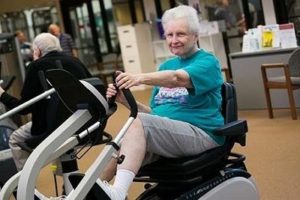
You can still exercise even if you have a health condition like heart disease, arthritis, chronic pain, high blood pressure, or diabetes. In fact, physical activity may help. For most older adults, physical activities like brisk walking, riding a bike, swimming, weightlifting, and gardening are safe, especially if you build up slowly. You may want to talk with your doctor about how your health condition might affect your ability to be active.
Researchers are assessing the benefit of exercise to delay mild cognitive impairment (MCI) in older adults and to improve brain function in older adults who may be at risk for developing Alzheimer’s disease. Older adults with MCI may be able to safely do more vigorous forms of exercise, similar to older adults without MCI, provided there are no other underlying health concerns.
Being active and getting exercise may help people with Alzheimer’s or another dementia feel better and can help them maintain a healthy weight and have regular toilet and sleep habits. If you are a caregiver, you can exercise together to make it more fun.
Tips for helping a person with dementia stay active
Take a walk together each day. Exercise is good for caregivers, too!
Use exercise videos or check your local TV guide to see if there is a program to help older adults exercise.
Dance to music.
Be realistic about how much activity can be done at one time. Several short “mini-workouts” may be best.
Make sure he or she wears comfortable clothes and shoes that fit well and are made for exercise.
Make sure he or she drinks water or juice after exercise.
Even if the person has trouble walking, they may be able to:
Do simple tasks around the home, such as sweeping and dusting.
Use a stationary bike.
Use soft rubber exercise balls or balloons for stretching or throwing back and forth.
Use stretching bands.
Lift weights or household items such as soup cans.
Exercising with Arthritis
For people with arthritis, exercise can reduce joint pain and stiffness. It can also help with losing weight, which reduces stress on the joints.
Flexibility exercises such as upper- and lower-body stretching and tai chi can help keep joints moving, relieve stiffness, and give you more freedom of movement for everyday activities.
Strengthening exercises, such as overhead arm raises, will help you maintain or add to your muscle strength to support and protect your joints.
Endurance exercises make the heart and arteries healthier and may lessen swelling in some joints. Try activities that don’t require a lot of weight on your joints, such as swimming and biking.
If you have arthritis, you may need to avoid some types of activity when joints are swollen or inflamed. If you have pain in a specific joint area, for example, you may need to focus on another area for a day or two.
Your heart keeps your body running. As you grow older, some changes in the heart and blood vessels are normal, but others are caused by disease. Choices you might make every day, such as eating healthy, maintaining a healthy weight, and aiming to be more physically active, can contribute to heart health. Inactive people are nearly twice as likely to develop heart disease as those who are active. A lack of physical activity can worsen other heart disease risk factors as well, such as high blood cholesterol and triglyceride levels, high blood pressure, diabetes, and prediabetes, being overweight and obesity. Being physically active is one of the most important things you can do to keep your heart healthy. Aim for at least 150 minutes of moderate-intensity aerobic activity a week.
